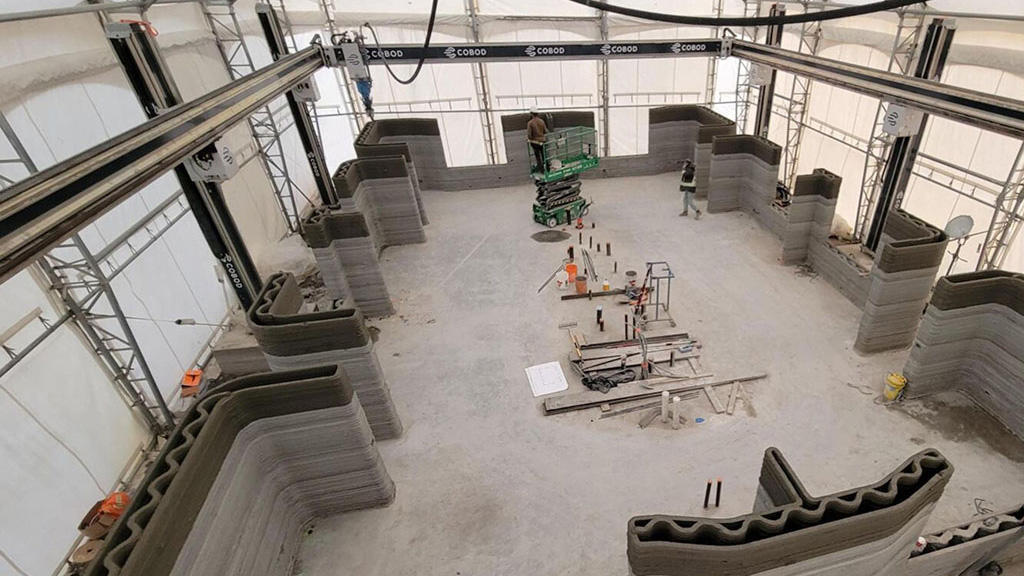In Canada, the soaring prices of homes have become one of the if not the biggest political issue at the moment, sparking widespread interest in possible solutions like 3D printing homes. In this area, the Canadian subsidiary of French cement giant Lafarge, is collaborating with nidus3D, an on-site 3D construction service firm, to make homes in the country.
nidus3D utilizes COBOD 3D printers for its construction projects. The firm’s latest endeavor involves creating 16 housing units in the SikSika Nation, a First Nation community located in southern Alberta. This initiative is particularly noteworthy because it aims to provide shelter to individuals facing domestic violence and those at risk of homelessness.
“Our shared goal with nidus3D extends beyond mere innovation. This project is about helping address the critical housing needs of the nation and foster a resilient, inclusive future through sustainable construction practices. We were proud to contribute to this project,” stated Lafarge Canada (West) president and CEO Brad Kohl.
Lafarge plans to use its OneCem cement for the project, which is meant to be 10% less polluting in terms of emissions compared to traditional Portland cement.
“This multi-build development will not only provide much needed housing but show the immense potential of 3D construction printing to address Canada’s housing crisis. This project will demonstrate efficiencies and savings the technology can deliver through rapid, repeatable construction,” said nidus3D President Ian Arthur.
nidus has a track record of printing units for Habitat for Humanity and creating North America’s first two-story 3D printed building. This approach to construction might reduce costs for homebuilders due to its lower labor requirements. Simultaneously, it can minimize material use and significantly cut down on formwork, potentially lowering expenses and diminishing the environmental impact of home building. Nevertheless, as our Editor in Chief Michael Molitch-Hou previously pointed out, this technology is unlikely to completely solve the housing crisis.
In the past decade, house prices in Canada have more than doubled. For those fortunate enough to afford a house in a major city, mortgage payments can consume a staggering 59% of household income. In a market like Ontario, the average sold price of a home was $750,000 in December 2018, which has now escalated to over $1 million. Since 2000, house prices in the country have increased more than fourfold. While GDP per capita has doubled during this period, incomes and disposable income haven’t kept pace with the soaring house prices.
Although the entry of foreign buyers and new immigrants adds pressure to the market, the primary driver appears to be the perception of homes as a sound long-term investment. This belief, increasingly shared by individuals and firms, fuels the conviction that house prices will continue to rise. The result is a surge in investment activity, with investors buying properties and developers focusing on high-end properties. Consequently, the existing market, particularly more affordable segments, is not adequately addressed.
Currently, Canadian society lacks a mechanism to swiftly increase income or to collectively construct low-cost housing on a large scale. In contrast, post-World War II Europe saw governments actively stimulating mass house building to meet the demand. Additionally, many countries have established housing associations specifically to provide low-cost housing. It appears that Canada has yet to devise a comparable solution for its current situation. According to some estimates, the housing shortfall in Canada could exceed 3 million units by 2030.
Unfortunately, I share the skepticism that 3D printing alone can magically alleviate the housing crisis, especially considering the vast scale required for impact and the current state of the industry. Moreover, the central issue is the high cost of houses, making them unaffordable for many, yet essential for everyone. This paradox turns houses into attractive investment assets, further driving up prices. However, there’s hope that Canada and other nations will develop a comprehensive set of incentives and plans to address this challenge. Despite no wealthy country currently appearing to work on a holistic solution to what is a major concern for voters, the future housing market will likely include more mature 3D printing solutions in some capacity. While 3D printed construction may not be the silver bullet for the housing crisis, it certainly has the potential to play a role in any future solution.
